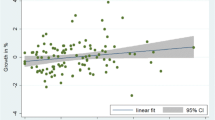Abstract
Sebestyén, Komlósi, and Szerb present a methodology to monetize the different pillars of the Regional Entrepreneurship Development Index (REDI). The REDI methodology provides a normalized value to describe the entrepreneurial ecosystem using natural units of the different measures as inputs to the calculation. To offer more informed policy analyses, the authors adopted a two-step approach. First, econometric techniques are employed to assign monetary values to the REDI variables. By entering the REDI scores into a production function explaining regional GDP levels, the authors estimate the marginal contribution of the REDI to regions’ monetized output, which they link to the marginal value of the REDI in a given region. Second, the authors use a standard shadow pricing approach in which the resulting monetized REDI score is traced back to its components, thus offering a monetized approximation of the pillars that form the REDI composite indicator. The analysis concludes with an exposition of the policy implications that can be drawn from analyses based on this approach.
Access this chapter
Tax calculation will be finalised at checkout
Purchases are for personal use only
Similar content being viewed by others
Notes
- 1.
The perpetual inventory method (PIM) is a method of constructing estimates of capital stock and consumption of fixed capital from time series of gross fixed capital formation. It allows an estimate to be made of the stock of fixed assets in existence and in the hands of producers, and it is generally based on estimating how many of the fixed assets installed as a result of gross fixed capital formation undertaken in previous years have survived to the current period (OECD, 2001).
- 2.
- 3.
Hayes, A.F. and Cia, L. (2007): Using heteroscedasticity-consistent standard error estimators in OLS regression: An introduction and software implementation. Behavior Research Methods, 39(4), 709–722. http://www.afhayes.com/spss-sas-and-mplus-macros-and-code.html
- 4.
The transformation procedure ensures that \( \sum \limits_i{y}_{i,p}/R=\overline{y} \) for all p (R is the number of regions).
- 5.
The reason for this is that under the optimal allocation, bottlenecks are eliminated, so the bracketed term in the objective function in (6) vanishes.
- 6.
From the 23 countries covered by the REDI, 17 appear in one of the reports, while 10 appear in both.
- 7.
The OECD report contains government consumption, government benefits (transfers), direct and indirect taxes. The ECB report estimates multipliers for government consumption, labor income tax, capital income tax, and consumption tax.
- 8.
Another approach could be using government transfers, but this would narrow down the basis for multiplier data to the OECD report.
- 9.
Although there is some variation, the long-run effects do not differ too much from the short-run effects.
References
Audretsch, D. B., & Belitski, M. (2017). Entrepreneurial ecosystems in cities: Establishing the framework conditions. Journal of Technology Transfer, 42(5), 1030–1051.
Barrell, R., Holland, D., & Hurst, I. (2012). Fiscal consolidation: Part 2. Fiscal multipliers and fiscal consolidations. OECD Economics Department Working Papers, No. 933, OECD Publishing.
Hayes, A. F., & Cia, L. (2007). Using heteroscedasticity-consistent standard error estimators in OLS regression: An introduction and software implementation. Behavior Research Methods, 39(4), 709–722.
Kilponen, J., Pisani, M., Schmidt, S., Corbo, V., Hledik, T., Hollmayr, J., Hurtado, S., Júlio, P., Kulikov, D., Lemoine, M., Lozej, M., Lundvall, H., Maria, J. R., Micallef, B., Papageorgiou, D., Rysanek, J., Sideris, D., Thomas, C., & De Walque, G. (2015). Comparing fiscal multipliers across models and countries in Europe. NBB Working Paper, No. 278, National Bank of Belgium, Brussels.
McCann, P. (2013). Modern urban and regional economics. Oxford University Press.
Meliciani, V., & Savona, M. (2015). The determinants of regional specialisation in business services: Agglomeration economies, vertical linkages and innovation. Journal of Economic Geography, 15, 387–416.
OECD. (2001). Measuring capital: OECD Manual, Annex 1 glossary of technical terms used in the manual. OECD.
Parr, J. B. (2002). Agglomeration economies: Ambiguities and confusions. Environment and Planning A, 34, 717–731.
Szerb, L., Acs, Z. J., Autio, E., Ortega-Argiles, R., & Komlosi, E. (2013). REDI: The regional entrepreneurship and development index–measuring regional entrepreneurship. Final report. European Commission, Directorate-General for Regional and Urban policy. REGIO DG.
Szerb, L., Vörös, Z. S., Komlósi, É., Acs, Z. J., Páger, B., Ortega-Argilés, R., & Abaligeti, G. (2017). The new regional entrepreneurship and development index: Structure, data and description of methodology. Unpublished manuscript.
White, H. (1980). A heteroscedasticity-consistent covariance matrix estimator and a direct test for heteroscedasticity. Econometrica, 48(4), 817–838.
Author information
Authors and Affiliations
Corresponding author
Editor information
Editors and Affiliations
Appendix
Appendix
Rights and permissions
Copyright information
© 2023 The Author(s), under exclusive license to Springer Nature Switzerland AG
About this chapter
Cite this chapter
Sebestyén, T., Komlósi, É., Szerb, L. (2023). The Monetization of the Regional Development and Innovation Index: Estimating the Cost of Entrepreneurship Ecosystem Policies in European Union Regions. In: Acs, Z.J., Lafuente, E., Szerb, L. (eds) The Entrepreneurial Ecosystem. Palgrave Studies in Entrepreneurship and Society. Palgrave Macmillan, Cham. https://doi.org/10.1007/978-3-031-25931-9_5
Download citation
DOI: https://doi.org/10.1007/978-3-031-25931-9_5
Published:
Publisher Name: Palgrave Macmillan, Cham
Print ISBN: 978-3-031-25930-2
Online ISBN: 978-3-031-25931-9
eBook Packages: Business and ManagementBusiness and Management (R0)




